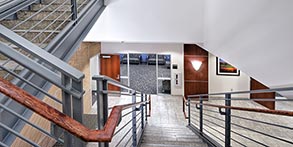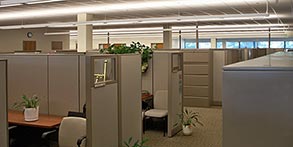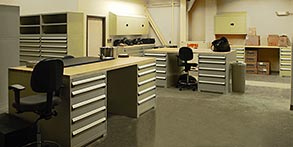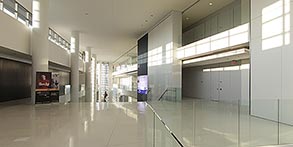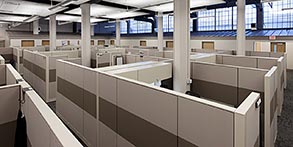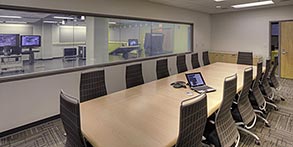- Include durability in the life-cycle cost analysis for best-value material selections with long life expectancies that do not show excessive wearing.
- Select long-lasting materials and finishes for permanent core areas such as lobbies, restrooms and stairs.
- Select low-maintenance materials and products that reduce ongoing servicing and repair and that are easy to clean.
- Relate the visual quality of finishes to the Facility Group number.
- Building and interior configurations should address both operations and climatic responses.
- Convey a professional image; avoid trendy patterns and textures.
- Use materials and finishes that provide a healthy indoor environment.
- Orient interior spaces toward views while maintaining cost-effective building performance and efficiency.
- Promote air movement and daylighting for human health and well being.
Provide open-plan configurations for office, administrative, operational and related activities and spaces for maximum flexibility. Use a “core and shell” approach in which all building systems, infrastructure and permanent interior partitions anticipate two or more uses (operations) during a facility’s lifespan. Create flexible interior configurations using Furniture, Fixtures & Equipment (FF&E) and limit private offices and private rooms. Refer to DAFMAN 32-1084 for space requirements. To the greatest extent, limit permanent partitions to core areas such as toilet rooms, stairs, mechanical and utility rooms. Use more durable long-lasting finishes in core areas for walls, ceilings, floor coverings and built-in casework. Coordinate interior FF&E layouts with structural grids.
Sustainability
Provide high-performance building configurations following UFC 1-200-02. Ensure passive design strategies are cost effectively incorporated before active mechanical systems are designed.
Fully integrate interior design to preserve and support passive systems and energy efficiencies. All passive systems such as thermal-mass walls, clerestories and daylighting systems, natural ventilation and convection cooling features, etc., must be sustained in interior design and renovations.
Resilience
Review and consider the potential impacts of documented risks when configuring interior spaces. Maintain and preserve integrated passive systems such as vestibules and thermal mass, which provide energy efficiency and comfort for occupants.
In areas at risk for tornadoes coordinate egress routes from interior spaces to storm shelters during the concept design phase of the facility design process and preserve these routes during the structural interior design and FF&E design process.
UFC 1-200-01 General Building Requirements https://www.wbdg.org/dod/ufc/ufc-1-200-01
UFC 1-200-02 High Performance and Sustainable Building Requirements https://www.wbdg.org/dod/ufc/ufc-1-200-02
UFC 3-120-10 Interior Design https://www.wbdg.org/dod/ufc/ufc-3-120-10
UFC 3-410-01 Heating, Ventilating, and Air Conditioning Systems https://www.wbdg.org/dod/ufc/ufc-3-410-01
UFC 3-450-01 Noise and Vibration Control https://www.wbdg.org/dod/ufc/ufc-3-450-01
UFC 4-010-05 Sensitive Compartmented Information Facilities Planning, Design, and Construction https://www.wbdg.org/dod/ufc/ufc-4-010-05
AFI 32-6002 U.S. Air Force Family Housing Planning, Programming, Design, and Construction https://static.e-publishing.af.mil/production/1/af_a4/publication/afi32-6002/afi32-6002.pdf
USAF/DOE Design Guide for Military Family Housing - Energy Efficient Revitalization and New Construction https://www.wbdg.org/FFC/AF/AFDG/milfam.pdf
US Air Force Family Housing Design Guide for Planning, Programming, Design and Construction https://www.wbdg.org/FFC/AF/AFDG/familyhousing.pdf
Department of the Air Force Manual (DAFMAN) 32-1084 Facility Requirements https://www.wbdg.org/FFC/AF/AFMAN/afman32-1084.pdf

